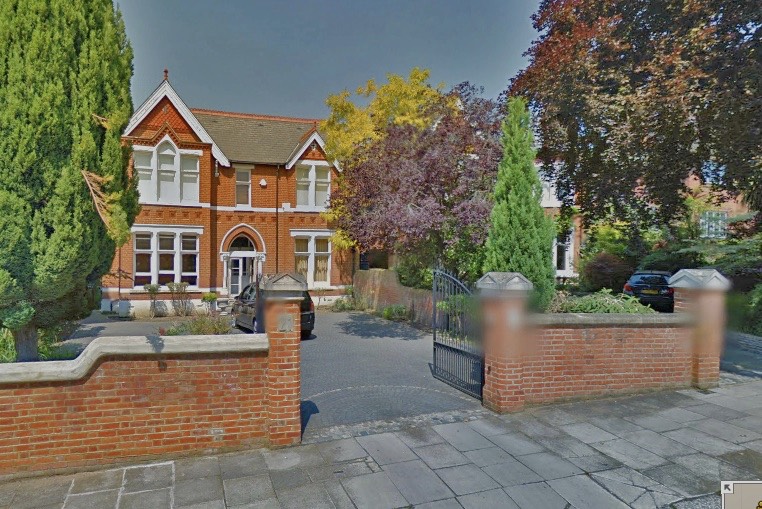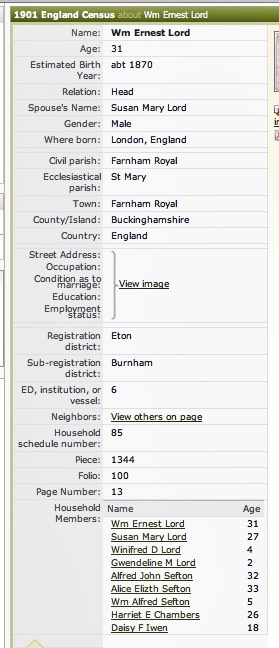Here is some information about UDL’s co-founder, Francis Ernest (but always known as Peter) Lord (FEPL):
1. Below is a current image of 18 Park Hill, Ealing where Peter grew up. Included purely to give an idea of his family's background:

2. And here is a summary of the census for the Lord household in 1901 - eleven years before Peter (initials: FEPL) was born, and not at the above address:

3. So here (above) are: Peter’s dad, William Ernest Lord (hence the “Ernest” in FEPL’s names) age 31, his mother, and his two elder sisters, of whom Winifred (born approx 1897 - same year as Bill Dykes) was to own the Ealing house, not far from 18 Park Hill (above), which she sold to Bill and Ruth Dykes in the late 1920s. That sale was the basic reason why the Dykes got to know the Lords and hence Bill Dykes got to know his (15 years younger) business-partner-to-be, which otherwise was most unlikely to have happened;
4. General Notes on FEPL (done 4.11.2012):
(a) FEPL’s article for the Bulletin of the 12/50 Alvis Register, (click-on the highlighted text to go to it) which I typed for him, and he submitted for publication (and it was published) explains in detail how FEPL came to know WUD&R (Bill and Ruth Dykes);
(b) It says:
“Bill and Ruth lived in the 1920s at Ealing, in a house formerly owned by my elder sister. It was a few hundred yards away from the house where I was born. On my way into the town or to school, I used to pass Bill and Ruth’s house and, like any schoolboy, look at their Alvis which often stood in their front garden. For several years it was a (to me) comparatively sober wide bodied two seater, but when running it had a wonderful 12/50 engine sound. It was their first Alvis, MF 4557.”
(c) So, it is clear that:
i) the connection with WUD&R arose because WUD&R happened to live in the 1920s (ie on settling in London after WUD’s demobilization after WW1 for WUD to train with Mewburn Ellis) in a house formerly owned by FEPL’s elder sister who (from the 1911 census) was called (he had two older sisters) ‘Winifred Dorothy’, who was 15 years older than him, or ‘Gwendoline Mary’ (!) who was 13 years older than him. Well, well.
ii) So, it is clear that the “UD-L” connection really exists only because one of FEPL’s elder sisters happened to sell or rent her house to the U-Ds when they were house-hunting some time in the 1920s – one of life’s chances (for the sake of a nail….etc);
iii) FEPL was born in 1912, when WUD was 15, so there was a significant age gap ie 3/5 of a generation, but it meant that when FEPL joined WUD as a pupil in 1934 (FEPL aged 22 and WUD aged 37), WUD had 9 years of experience post-qualification (in 1925), and so was in a very good position to train his new recruit;
iv) WUD’s background was Scottish public school and ‘the military’ (RFC and WW1), whereas FEPL’s was English public school and Cambridge University. But there was clearly an affinity between them, which served them well and FEPL qualified in two years, in 1936. By 1939 and the start of WW2, according to RHH’s timeline: “Peter Lord handled most of the patent work and W.Urquhart Dykes handled trade marks”.
v) at the end of WW2 they emerged from the RAF in the ranks of: WUD: Flight Lieutenant; and FEPL: Wing Commander (cf the ranks in the RAF consist of: (i) Officer cadet; (ii) Acting pilot officer; (iii) Flying officer; (iv) Flight Lieutenant; (v) Squadron Leader; (vi) Wing Commander; (vii) Group Captain; (viii) Air Commodore; (ix) Air Vice Marshall);
vi) interestingly, both partners worked in London and (quoting from RHH’s timeline): “From the time Fairburn-Hart retired in 1934, all through the war years and up to 1970 (ie 36 years) the Leeds Office was run by his long serving technical assistant, John Selby and his secretary, Alice Turner, with periodic visits from the Partners and after he joined in 1947, R.Harris (Snr)”;
d) Extracting facts from RHH’s timline:
London Office locations:
(i) Clun House, Surrey Street, from 1927 when WUD joined GGMH there, to 1929; (2 years)
(ii) 75 Chancery Lane, same building as Mewburn Ellis: 1929 to 1939 (when the office was bombed); (10 years)
(iii) 1939 to 1946: premises in Ealing with Mewburn Ellis during the war, and Mewburn Ellis acted as caretaker for the firm; (7 years)
(iv) Maxwell House, Arundel Street (two streets from Surrey Street): 1946 to 1969; (23 years)
(v) Columbia House, The Aldwych (about ¼ mile from Maxwell House): 1969 to 1973; (4 years)
(vi) St Martin’s House, Tottenham Court Road: 1973 to 1981; (8 years)
(vii) 47 Marylebone Lane, W1: 1981 to ?
Subsequent addresses for London Office were:
(viii) 92(?) Wimpole Street plus Cavendish Square (FJW and TDM only, I recollect), and then:
(ix) Welbeck Street up to about 2011 or 2012 – these addresses seem not to be mentioned in RHH’s timeline, though they were clearly within his time frame of up to2003;
Leeds Office locations:
(i) 1874 to ?: 1 East Parade;
(ii) ? to 1970: 12 South Parade;
(iii) 1970 to date: Tower House, Merrion Way;
5. Peter Lord’s history of UD&L:
The official history of the firm was written by John Longrigg in consultation with FEPL and others. It is called "Persons of Skill and Probity" (POSP). This (as I think) rather off-putting title has historical origins which John Longrigg explains in the book. Please click on the acronym: POSP to gain access to the 21 pages of the text of the book;